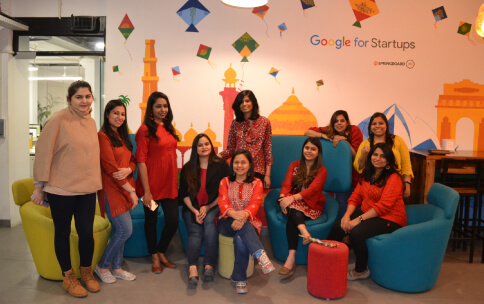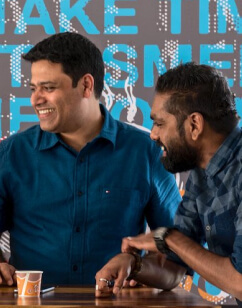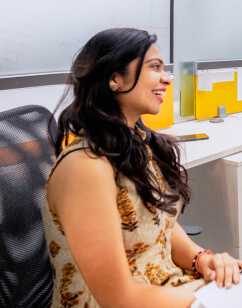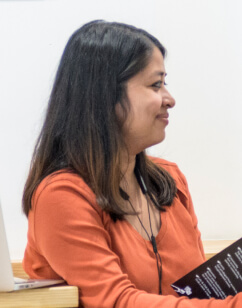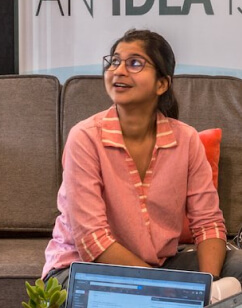11 November 2023
We used to think cubicles were horrible, now we know they are!
Scott Wyatt,Designer
Picture a building as you read that quote again, and you will almost certainly think of your office. Whether that image triggers joy or anxiety depends – to a certain extent – on how well it’s been designed.
There’s a number of elements that go into designing the right work space. We often tend to think of workspaces as a collection of tables, chairs, separators, conference rooms, break rooms, laptops, printers… sprinkle them around an empty room, and voila you have an office!
In reality, things are a lot more complex, and how one or all of these items are arranged has a direct impact on your workforce’s mood and productivity.
“We used to think cubicles were horrible, now we know they are!” Scott Wyatt says in his Ted Talk. Scott is a partner at NBBJ, an architecture firm named one of the most innovative businesses in the world by Fast Company. Cubicles are the perfect example of how design can negatively impact your workforce. In theory it has everything listed in the paragraph above, from tables to separators… but in practice it creates an environment of stress and decreased productivity.
That’s great, no cubicles, but what’s actually needed for productivity?
“To do our work we need three things. Clear goals, time to focus, and distraction-free workspace,” says Creative Director, Matthew Encina on his Youtube Channel. Clear goals and time to focus depend on the workforce themselves, but a distraction-free workspace comes down to design.
Is the workspace well lit, or does it have lights that could induce a migraine in 15 minutes? Are the walls good enough to absorb sound, or does it feel like a pub hosting the Manchester Derby? Do we have dedicated quiet spaces for focussed work to be carried out? How about break areas, so that you can step away from work without needing to step out of work? Are there options to keep your desk clutter free? What about the walls, are they shocking shades of pink and yellow or have we gone for blue to enhance focus, or green to promote a sense of calm and balance. What about the furniture… wait, what about that furniture?

Drop into one of 91springboard's 28 hubs to experience the joy of design first hand
Doesn’t the furniture just have to be fancy?
When it comes to furniture in a workspace, there’s a few things that need to be considered – comfort, material and ease of handling.
Take a chair for instance. It’s not just about whether the chair is visually appealing. Can you move the chair around easily, or do you need to start doing 100 push-ups from tomorrow to be able to change your seating arrangement? Does it feel comfortable enough to sit on for long hours through the day, or will you need to book yourself in for a Thai Spa later this evening? Is the material right, or are we going to spend the rest of the day getting static shocks on door handles because of the fiber used in our chair? The last one can be particularly painful!
Speaking of chairs, what about tables, especially ones in conference rooms. Is it the right size to sit across from each other and have a conversation, or are you going to find out if your counterpart had a fish steak for lunch? Is it close enough, or are you going to have to yell to make a point? All of this defines how well a meeting can go, or if you’re going to land that pitch deck right.
So, walls, lighting, furniture and you’ve got the perfect office, right?
How an office space feels extends beyond the tables and chairs in the room. Architects now try to bring in an element of biophilia when they design workspaces. This is the concept of bringing in a part of nature within the office space, because humans have a long standing bond with nature. When we see nature around us, we feel at home. Wyatt in his Ted Talk says “What we’ve learnt is that if you’re sitting at your desk and you can see a tree within 100 feet, your cognitive performance goes up and your stress goes down.”

91Springboard: DLF CyberCity
How an office space feels extends beyond the tables and chairs in the room. Architects now try to bring in an element of biophilia when they design workspaces.
Sometimes the right kind of office space depends on what kind of work you’re engaged in. If you’re in legal, then glass walls may not be your friend… after all there’s a lot of confidential documents you need to keep confidential. Love high ceilings, but work in accounting or tech? Wyatt has a contrasting suggestion for you. “If you have a low ceiling, your cognitive performance for mathematics will improve.”
At the end of the day, the right office design comes by putting people and their needs first…
And a workspace is not just the construction, it’s also the people
Let’s face it, we go to the office not just to finish our tasks but to collaborate and network with others on our collective goals. A good office design enables us to be able to have interaction opportunities with others in the space.
“What truly drives us is so much more nuanced than simply the number or placement of walls around us. Good office design considers elements such as the number of face-to-face interactions that we are likely to have in a day. Because we are social beings,” Amanda LeClair in her Ted Talk. LeClair is a Research Analyst at Forrester Research where she focuses on how our jobs and our everyday working environments are changing. Having dedicated areas where people can meet is important, but the office also needs to be designed in a manner that allows for people to walk up to each other and have a conversation freely. Communal areas allow for people to collaborate, facilitates teamwork and encourages idea sharing.
A well-designed office space allows one to not be tied down to their desk all day.
Ok, but what about when we do need to be seated at our desks?
Well, congratulations, here’s where you (the workforce) get to become the designer. The focus at your desk needs to be on ergonomics, comfort and a lack of clutter. This is what will allow you to stay focussed, energised and maintain concentration through the day. There’s several simple things that can help you create the perfect desk space.
Pay attention, because these are tips that would work at your home workspace as well.
- Guilty of leaving your phone at the edge of your desk, waiting to catch an errant elbow? How about a phone dock… it saves your phone’s life, organizes your space and reduces clutter.
- Does your desk have slots for charging your electronics, are there spaces for you to place your cables in so that you don’t have a forest of wires on your desk?
- What about a desk shelf to stow away things you might not need at the moment, but could reach for later in the day?
- An ergonomic desk mat goes a long way in keeping your laptop and mouse organized and functional on the table.
Oh and by the way, you don’t always need to be seated at your desk. A standing desk helps with posture, and also adds a sense of urgency when attending to tasks such as responding to emails.
Great, now tell me all of this in the size of an email!
Investing in good design is not just a matter of aesthetics; it directly impacts work and productivity. By prioritising employee comfort, optimising layouts, leveraging design psychology, and incorporating collaborative spaces, organisations can create a work environment that fosters efficiency, creativity, and overall well-being.
As Wyatt says, “Will we choose to build workspaces that distract, or workspaces that motivate? Design gives us that choice.”
Share this post

